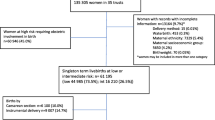Abstract
A retrospective analysis of 1000 waterbirths, compared to 1000 spontaneous births outside water, showed no increased neonatal or maternal morbidity or mortality. In water the consumption of analgesics was significantly lower (1.1% compared with 20.1%) and the rate of episiotomies less than half (the rate of peripheral birth traumas, however, was slightly higher in the waterbirth group: 53% vs 49%). Regarding the other parameters examined, there were no significant differences. Criticism of waterbirths is obviously based on assumptions that are not compatible with new insights into fetal physiology and respiratory adaptation of the newborn. If the results of basic research are included in the assessment of the clinical situation, some of the phenomena not unterstood so far are explained. Others, especially the different biochemical and pharmacological influences on the neonatal respiratory regulation and adaptation, require further research.
Zusammenfassung
Anhand der Ergebnisse unserer 1000 retrospektiv untersuchten Wassergeburten — verglichen mit 1000 Spontangeburten außerhalb des Wassers — stellten wir fest, daß keine erhöhte kindliche und mütterliche Morbidität und Mortalität nachgewiesen werden konnte. Im Wasser war der Medikamentenverbrauch deutlich niedriger [1,1% zu 20,1%] und die Rate an Episiotomien um die Hälfte geringer (die Zahl perinealer Geburtsverletzungen lag bei den Entbindungen im Wasser jedoch etwas höher [53% zu 49%]). Bezüglich der übrigen untersuchten Parameter ergaben sich keine signifikanten Unterschiede. Die bisweilen geäußerte Kritik an der Durchführung von Wassergeburten beruht offensichtlich auf Annahmen, die dem heutigen Erkenntnisstand der fetalen Physiologie und der respiratorischen Adaptation des Neugeborenen nicht mehr entsprechen. Bezieht man die Ergebnisse der Grundlagenforschung mit in die Beurteilung der klinischen Situation ein, so erklären sich manche bisher unverstandene Phänomene. Andere (insbesondere die verschiedenen biochemischen und pharmakologischen Einflüsse auf die neonatale Atemregulation und -adaptation) bleiben weiterer Forschung vorbehalten.
Similar content being viewed by others
Literatur
Alcorn D et al. (1980) Morphological effects of chronic bilateral phrenectomy or vagotomy in the fetal lumb lung. Anat 13:683
Angell-James JE, Daly M de B (1972) Some mechanisms involved in the cardiovascular adaptation to diving. University Press, Cambridge
Barcroft J (1977) The onset of respiratory movements. Researchers on Pre-Natal Life. Oxford, Blackwell Scientific Publications
Bland RD (1983) Dynamics of pulmonary water before and after birth. Acta Paediatr Scand [Suppl] 305:12
Boddy K et al. (1974) Fetal respiratory movements, electrocortical and cardiovascular responses to hypercapnia in sheep. J Physiol (London) 243:599
Dawes GS et al. (1974) Breathing before birth in animal and man. New Engl J Med 290:557
Eldering G et al. (1995) Entwicklung der alternativen Geburtshilfe am Beispiel der Frauenklinik Bensberg. In: Siebert W, Eldering G (Hrsg) Alternativen der klinischen Geburtshilfe. Marseille
Harned HS Jr et al. (1970) The effect of immersion and temperature on respiration in newborn lambs. Pediatrics 45:4
Hasan SU et al. (1988) Effect of morphine on breathing and behaviour in fetal sheep. J Appl Physiol 64:2058
Karlberg P et al. (1962) Alteration of the infants thorax during vaginal delivery. Acta Obstet Gynecol Scand 41:223
Lenstrup C et al. (1987) Warm tub bath during delivery. Acta Obstet Gynecol Scand 66:709
Merlet C et al. (1970) Mise en evidence de mouvement respiratoirez chez le foetus d’agneau. Cr Acad Sci Ser D 270:2462
Negus VE (1929) The mechanism of the larynx. Heinemann, London
Selke K et al. (1995) Wassergeburt - eine mögliche Entbindungsform? In: Siebert E, Eldering G (Hrsg) Alternativen der klinischen Geburtshilfe
Tchobroutsky C et al. (1969) The diving reflex in rabbit, sheep and newborn lamb and its afferent pathways. Resp Physiol 8:108
Walters DW et al. (1978) Pediatr Res 12:239
Wealthall SR (1975) Factors resulting in a failure to interrupt apnea. In: Boma JF (ed) Development of upper respiratory anatomy and function - Symposium
Zimmermann R et al. (1993) Die Hebamme 6:71
Author information
Authors and Affiliations
Rights and permissions
About this article
Cite this article
Eldering, G. Wassergeburt — eine mögliche Entbindungsform?. PerinatalMedizin 9, 40–44 (1997). https://doi.org/10.1007/s001520050048
Published:
Issue Date:
DOI: https://doi.org/10.1007/s001520050048
Key words
- Waterbirth
- Diving reflex
- Fetal breathing movements
- Fetal lung fluid
- Squeezing effect
- CTG monitoring
- Telemetric recording
- Apgar score
- Umbilical cord pH
- Fetal morbidity and mortality




